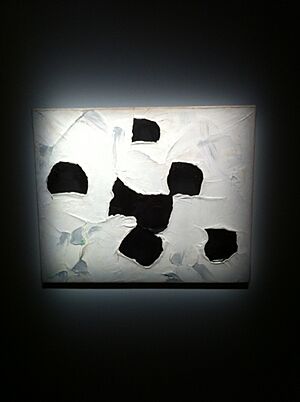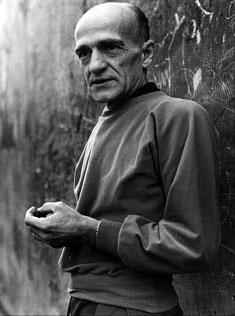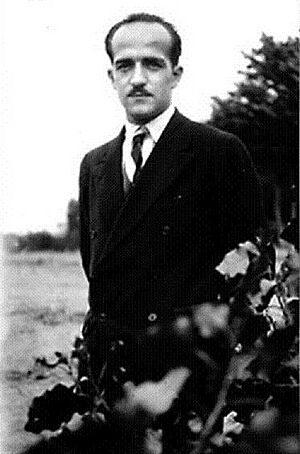Paul-Émile Borduas facts for kids

Paul-Émile Borduas (born November 1, 1905 – died February 22, 1960) was an important artist from Quebec, Canada. He was famous for his abstract paintings, which means his art didn't show real-life objects. Borduas led a group of artists called the Automatiste movement. He also wrote a very important statement called the Refus Global in 1948. His ideas greatly changed art and thinking in Quebec and Canada.
Contents
Paul-Émile Borduas' Early Life
Borduas was born on November 1, 1905, in Saint-Hilaire, Quebec. This was a small village about 50 kilometers from Montréal. He was the fourth child in his family. As a kid, he loved to build things from different materials, which was his first step into art. He went to elementary school for five years, finishing when he was twelve. He also had some private lessons.
Learning to Be an Artist
When he was a teenager, Borduas met Ozias Leduc, a painter who decorated churches. Leduc saw Borduas' talent and took him on as an apprentice. This meant Borduas learned basic art skills from Leduc. He learned how to restore and decorate churches. Leduc also helped Borduas get into art schools.
In 1919, Borduas studied at the École Technique in Sherbrooke, Quebec. In 1923, with a scholarship from Leduc, he went to the École des Beaux-Arts de Montréal. He worked for Leduc at the same time. Borduas won awards for his paintings at both schools. Even though he had some disagreements with the school leaders, he kept studying because Leduc encouraged him.
Becoming a Teacher and Finding His Voice
After finishing school in 1927, Borduas became a high school art teacher in Montreal. In 1929, he went to Paris, France, to study at the Ateliers d'Art Sacré. He also worked on church decorations there. He returned to Saint-Hilaire in 1930 because he ran out of money. He started teaching part-time and then full-time again in 1933.
In 1937, Borduas began teaching at l'École du Meuble. This was a key time for him. He met young people who shared his interests and desire for change. This gave him a stimulating environment to grow his ideas.
The Automatistes Movement
In 1938, Borduas met John Goodwin Lyman, a painter and art critic. Lyman encouraged Borduas to join the Contemporary Arts Society. Borduas became the group's vice-president in 1938.
After several years of teaching, Borduas started painting again in 1941. He and his students often met to talk about new art styles from Europe. His first abstract paintings were made this year. In 1942, he showed 45 of his paintings that were inspired by the abstract art of Joan Miró.
Borduas grew close to about a dozen of his students. They became known as the Automatistes. They tried to paint using "pure psychic automatism." This meant they painted without thinking too much, letting their subconscious guide their hand, like in the writings of André Breton.
In 1946, Borduas and his students had their first group art show in New York City. In 1947, they had another show in Montreal. This was the first time a group of abstract painters showed their work in Canada. A critic later called the group "Automatists" after Borduas' painting Automatisme 1.47.
The Refus Global Manifesto
Borduas wrote Refus Global (which means "Total Refusal") in 1947-1948. This was a very important statement that called for big changes in Quebec society. It asked for the separation of church and state, especially in the arts. Borduas felt that Quebec was a "suffocating environment" that stopped people from being creative.
In Refus Global, Borduas wrote about wanting a future where people are free. He imagined a world where everyone could use their unique talents. He said they would keep working for freedom, even if it was hard.
Four hundred copies of the manifesto were sold on August 9, 1948. Because of his involvement, Borduas was fired from l'École du Meuble on September 2. Many people, even those who wanted change, were afraid to support Borduas' strong criticism of the Catholic Church. The Church had a very big influence on French Canadians at the time.
Borduas found it hard to get a job after this, especially since he was a father. He wrote another piece called Projections Libérantes ("Liberating Projections") in 1949. This writing explained his ideas more gently, but it still wasn't well received. However, even with the early criticism, the Refus Global started a period of big social change in Quebec. It helped begin the Quiet Revolution, a time of rapid change and modernization.
Later Life and Legacy
In 1953, Borduas moved to New York. There, he saw the works of famous American abstract painters like Jackson Pollock. He started using a palette knife to apply paint to his canvases. In 1955, he moved back to Paris, France, where he sadly died of a heart attack in 1960.
Borduas' art was shown in important exhibitions around the world. In 1954, his paintings, along with those of other Canadian artists, represented Canada at the Venice Biennale. This is a very famous art exhibition. In 1955, he represented Canada at another big art show in Brazil. After he died, a museum in Amsterdam held a special exhibition of his work in 1960. In 1988, the Montreal Museum of Fine Arts held a huge show of his art.
Borduas' paintings are still very valuable. In 2018, one of his paintings from 1956, called Figures schématiques, sold for a record-breaking amount at an auction.
Recognition and Honors
- Since 1977, the top award for visual arts in Quebec, the Prix du Québec, is named the Prix Paul-Émile-Borduas.
- On May 22, 1981, Canada Post released a stamp featuring one of his paintings.
- In 1998, all the people who signed the Refus Global manifesto received the Prix Condorcet.
Images for kids





